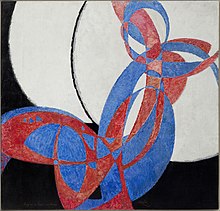This Term Describes Art That Relies on Geometric Shapes and Patterns to Depict an Object


Geometric abstraction is a form of abstruse art based on the use of geometric forms sometimes, though not always, placed in non-illusionistic space and combined into non-objective (non-representational) compositions. Although the genre was popularized past advanced artists in the early twentieth century, similar motifs have been used in art since ancient times.
History [edit]
Geometric brainchild is present among many cultures throughout history both equally decorative motifs and every bit art pieces themselves. Islamic art, in its prohibition of depicting religious figures, is a prime example of this geometric blueprint-based art, which existed centuries before the movement in Europe and in many means influenced this Western school. Aligned with and often used in the architecture of Islamic civilations spanning the 7th century-20th century, geometric patterns were used to visually connect spirituality with scientific discipline and art, both of which were key to Islamic thought of the time.
Scholarly assay [edit]

Throughout 20th-century art historical discourse, critics and artists working within the reductive or pure strains of abstraction have often suggested that geometric brainchild represents the top of a not-objective fine art exercise, which necessarily stresses or calls attending to the root plasticity and 2-dimensionality of painting as an creative medium. Thus, it has been suggested that geometric abstraction might function as a solution to problems concerning the need for modernist painting to reject the illusionistic practices of the past while addressing the inherently 2 dimensional nature of the picture plane as well as the canvas functioning as its support. Wassily Kandinsky, i of the forerunners of pure non-objective painting, was amid the first modern artists to explore this geometric arroyo in his abstract work. Other examples of pioneer abstractionists such as Kasimir Malevich and Piet Mondrian have also embraced this approach towards abstract painting. Mondrian's painting "Limerick No. 10" (1939–1942) conspicuously defines his radical but classical approach to the structure of horizontal and vertical lines, as Mondrian wrote, "synthetic with awareness, only not with calculation, led by high intuition, and brought to harmony and rhythm."[one]
Just every bit there are both two-dimensional and three-dimensional geometries, the abstract sculpture of the 20th century was of class no less affected than painting by geometricizing tendencies. Georges Vantongerloo[2] and Max Neb,[3] for case, are perhaps best known for their geometric sculpture, although both of them were as well painters; and indeed, the ideals of geometric brainchild find nearly perfect expression in their titling (e.g., Vantongerloo's "Construction in the Sphere") and pronouncements (e.chiliad., Neb's statement that "I am of the stance that it is possible to develop an fine art largely on the basis of mathematical thinking.") Expressionist abstract painting, as good by artists such as Jackson Pollock, Franz Kline, Clyfford Still, and Wols, represents the opposite of geometric abstraction.
Human relationship with music [edit]
Abstruse art has also historically been likened to music in its ability to convey emotional or expressive feelings and ideas without reliance upon or reference to recognizable objective forms already existent in reality. Wassily Kandinsky has discussed this connectedness between music and painting, as well as how the practice of classical composition had influenced his work, at length in his seminal essay Apropos the Spiritual in Art.
Selected artists [edit]
Artists who take worked extensively in geometric abstraction include:
- Nadir Afonso
- Josef Albers
- Richard Anuszkiewicz
- Mino Argento[4]
- Hans Arp
- Rudolf Bauer
- Willi Baumeister
- Karl Benjamin
- Max Pecker
- Ilya Bolotowsky
- Patrick Henry Bruce
- Kenneth Wayne Bushnell
- Norman Carlberg
- Ilya Chashnik
- Joseph Csaky
- Nassos Daphnis
- Ronald Davis
- Robert Delaunay
- Sonia Delaunay
- Tony DeLap
- Jean Dewasne
- Burgoyne Diller
- David Diao
- Ding Yi
- Theo van Doesburg
- Thomas Downing
- Lorser Feitelson
- María Freire
- Günter Fruhtrunk
- Albert Gleizes
- Frederick Hammersley
- Erwin Hauer
- Mary Henry
- Gottfried Honegger
- Bryce Hudson
- Al Held
- Auguste Herbin
- Carmen Herrera
- Hans Hofmann
- Budd Hopkins
- Wassily Kandinsky
- Ellsworth Kelly
- Hilma af Klint
- Ivan Kliun
- František Kupka
- Pat Lipsky
- El Lissitzky
- Michael Loew
- Peter Lowe
- Kazimir Malevich
- Agnes Martin
- Kenneth Martin
- John McLaughlin
- Peter Hugo McClure
- László Moholy-Nagy
- Vera Molnár
- Piet Mondrian
- François Morellet
- Aurélie Nemours
- Barnett Newman
- Kenneth Noland
- Alejandro Otero
- Rinaldo Paluzzi
- I. Rice Pereira
- Francis Picabia
- Ad Reinhardt
- Jack Reilly
- Bridget Riley
- Ivo Ringe
- Alexander Rodchenko
- Morgan Russell
- Sean Scully
- Victor Servranckx
- Leon Polk Smith
- Henryk Stażewski
- Jeffrey Steele
- Frank Stella
- Adam Szentpétery
- Sophie Taeuber-Arp
- Leo Valledor
- Georges Vantongerloo
- Victor Vasarely
- Friedrich Vordemberge-Gildewart
- Charmion von Wiegand
- Zanis Waldheims
- Gordon Walters
- Neil Williams
- Stanton Macdonald-Wright
- Larry Zox
See also [edit]
- American Abstract Artists
- Physical fine art
- Formalism (art)
- Hard-border painting
- Lyrical Abstraction
- Mail-painterly brainchild
- Shaped sail
References [edit]
- ^ Tosaki, Eiichi (2017). Mondrian's Philosophy of Visual Rhythm. Springer. p. 110. ISBN978-9402411980.
- ^ "The Collection: Georges Vantongerloo". The Museum of Mod Art. Retrieved Apr 24, 2015.
- ^ Smith, Roberta (December 14, 1994). "Max Bill, 85, Painter, Sculptor And Architect in Austere Style". New York Times . Retrieved Apr 24, 2015.
- ^ The Archives of American Art, Smithsonian, Betty Parsons Gallery Papers, Reel 4087–4089: Exhibition Records, Reel 4108: Artists Files, last names A-B.
External links [edit]
- Sculpture and Fine art Websites at DMOZ
- Geoform
sinclairyoupe1966.blogspot.com
Source: https://en.wikipedia.org/wiki/Geometric_abstraction
0 Response to "This Term Describes Art That Relies on Geometric Shapes and Patterns to Depict an Object"
Post a Comment